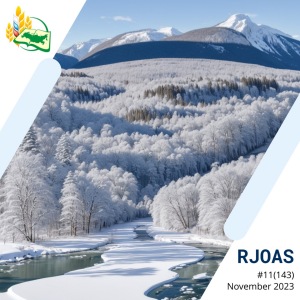ISSUE 6(18), June 2013 |
Pages 3-7
Title
RESEARCH AND RESTORATION OF INLAND WATERS OF DAGESTAN AND THE TEREK RIVER IN ORDER TO INCREASE FISH PRODUCTION
Author(s)
Khizrieva S.I., Abdullaeva N.M.
Organization(s)
Dagestan State University, Makhachkala, Russia
Key Words
Fish fauna; Hydrology; Fish production; Regulation; Water logging; Fishing; Juveniles.
Abstract
The rational use of fish stocks and increase their productivity is one of the most important and urgent problems of fisheries. One of the important areas in the fishing and for the reproduction of fish on the west coast of the Caspian Sea is the basin of the Terek River. For long period (over 40 years) without the required amount of water and in the absence of improvement measures in reservoirs downstream of the Terek River deteriorated environmental conditions. Efficiency and productivity of the natural reproduction of fish fell. To raise the value of water bodies requires the implementation of integrated fisheries management activities, and thereby restore the original state and to improve water bodies.
CrossRef DOI
Pages 8-14
Title
ARE THE REAL GDP SERIES IN ASIAN COUNTRIES NONSTATIONARY OR NONLINEAR STATIONARY?
Author(s)
Nurun Nahar Jannati, Nayeem Sultana, Md. Israt Rayhan
Organization(s)
University of Dhaka, Dhaka-1000, Bangladesh
Key Words
Autoregressive model; Nonlinearity; Unit root test.
Abstract
This paper checks whether per capita real gross domestic product (GDP) series in 16 Asian countries are nonstationary or nonlinear and globally stationary during the period from 1970 to 2009, by applying the nonlinear unit root tests developed by Kapitanios, Shin and Snell (2003). In five out of the sixteen countries that is approximately one-third of the countries, the series are found to be stationary with asymmetric or nonlinear mean reversion. Analyses depict that nonlinear unit root test are suitable for some cases compare to the commonly used unit root test, Augmented Dickey-Fuller (ADF) and Dickey-Fuller Generalized Least Square (DF-GLS) tests.
CrossRef DOI
Pages 15-26
Title
CONFLICTS, CONTESTATION AND MARGINALIZATION IN URBAN AGRICULTURE: EXPERIENCES FROM KUWADZANA EXTENSION, HARARE
Author(s)
Taru J., Basure H.S.
Organization(s)
Great Zimbabwe University, Masvingo, Zimbabwe
Key Words
Urban agriculture; Conflicts; Contestations; Perceptions; Ideologies; Interface analysis; Access to land; Land ownership regimes; Conflict resolution mechanisms.
Abstract
This study applied Norman Long's interface analysis in capturing and understanding causes of conflicts and struggles among actors practicing urban agriculture (UA) in Kuwadzana Extension. The benefits accrued by actors engaging in UA have attracted many actors to join the activity. An increase in the number of actors involved in urban agriculture has intensified competition for land and water that are scarce. This has increased struggles and contestations among various actors involved in the practice of UA. Focus of this study was on off-plot agriculture because of its contentious nature as it is practiced outside institutional frameworks that govern and regulate farming activities, access to land and water, conflict resolution and actors' interaction. A number of actors (farmers, Kuwadzana residents, council, church members) with different lifeworlds, divergent objectives, conflicting perceptions and opposing belief systems interact at the interface. Actors possess different power bases, which are used to dispossess and marginalize other actors. Inheritance, borrowing, renting, social networks and patronage are some of the ways that mediate access to land for farmers. These ways of accessing land escalated conflicts due to continuous boundary encroachment by actors who take advantage of lack of formal institution governing the practice of UA. The study captured conflict resolution mechanisms such as mediation, litigation and conciliation that are employed to resolve disputes. The efficacy of these conflict resolution mechanisms were examined, often, these mechanisms were neither legally binding nor have institutional backing, hence, these mechanisms have a tendency to generate more disputes.
CrossRef DOI




























